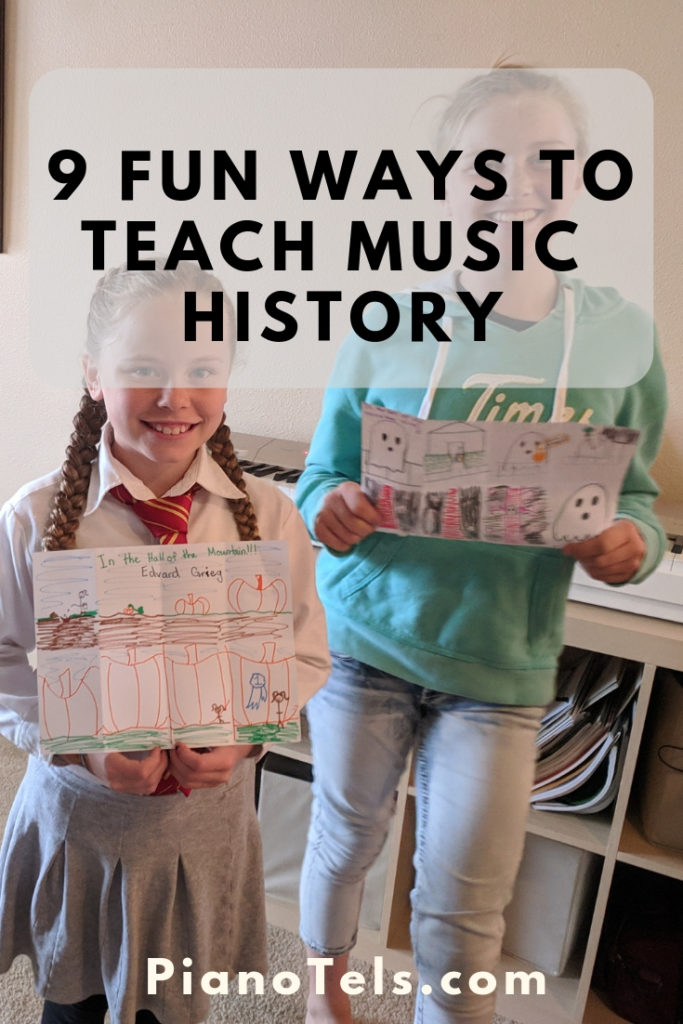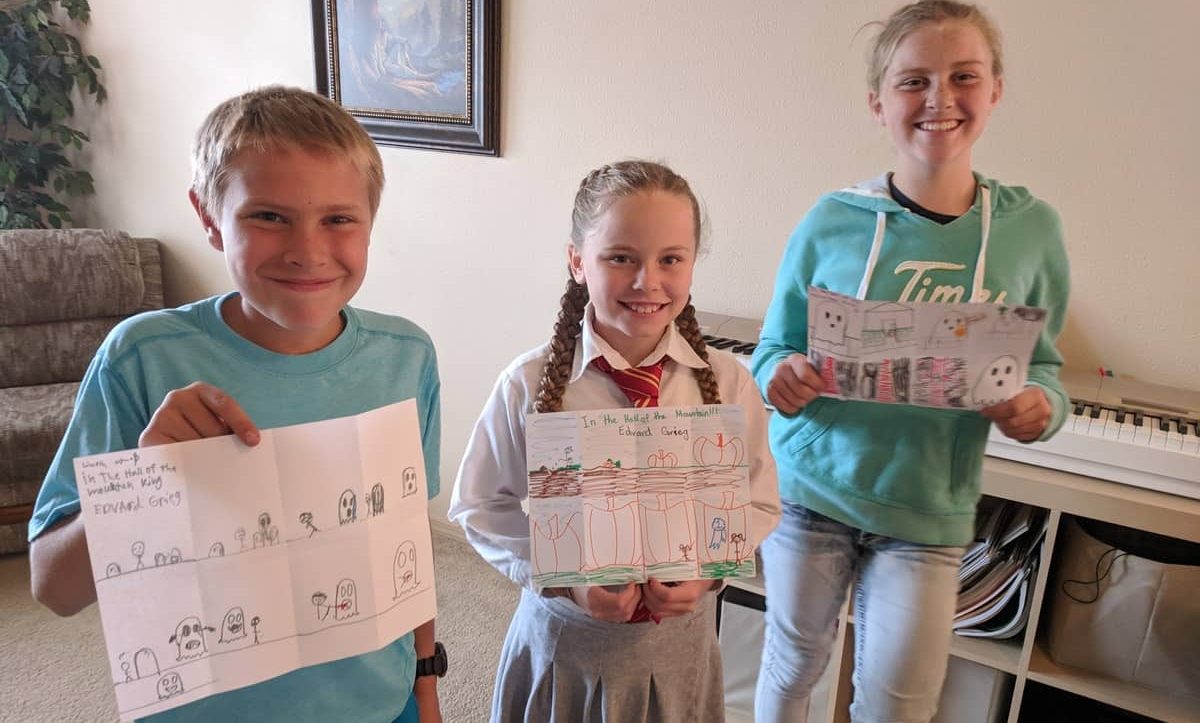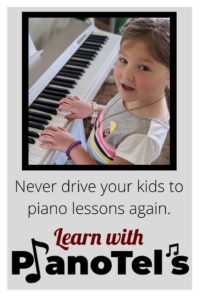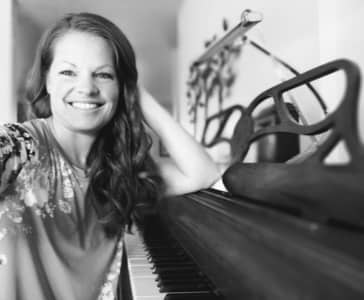After 17 years of searching for creative, fun, or ANY way to teach music history to my piano students….here it is! When my students give a cheer when I say, “music history”, you know you have figured out something right!

“Music history” can be anything from studying a song in any era, learning about the life of a composer, and/or studying the traits, timeframes, and influence of specific musical eras. This list of fun ways to teach music history includes all of these aspects of studying the history of music.
“My mission is to make history as interesting as it really was.” David McCullough
Check out these fun ways to teach music history, whether to an individual student, a group, or a class.
1. Draw, or write a story to a song
A very quick and easy way to incorporate music history into your lessons is to pick a song to have the students listen to. As they listen, have them pay attention to what story or picture the song creates in their head. After listening to the song once, I allow them to draw or write out that song on paper as we listen to the song again and again until they finish. They love this activity and it allows the student to “own” the song as they create their own interpretations of it. They then can share with the class what they pictured, drew, or wrote.
These students created their stories of “In the Hall of the Mountain King” by Edvard Grieg:

2. Create, or follow along on a listening map
A listening map is a visual representation of a song. A listening map allows the student to make the song (something abstract) into a concrete representation. It is helpful for understanding the development of the song. It trains the ear to listen for nuances, for dynamics, for changes in keys, instruments, etc.
For some examples of listening maps, check out:
- Carnival of the Animals listening map
- Peter and the Wolf with all of the characters on separate listening maps. This is an adorable lesson put together by musicforhomeschoolers-loretta.blogspot.com.
- There are about 15 listening maps you can print for free on makingmusicfun.net (scroll down to Listening Maps and Listening Glyphs)
- Visual Listening Maps from faculty.weber.edu
- WARNING! An original copy of these recordings is housed in the WSU Stewart Library or in the personal collection of Thomas Priest. Although you may listen to these recordings while on line and you may follow the listening maps, it is unlawful for you to download these selections and add them to your personal collection.
- Sabre Dance
- Postal Workers from Ghana (timbres)
- Postal Workers from Ghana (rhythmic organization)
- Postal Workers (Melodic Contour)
- Variations on a Shaker Theme from Appalachian Spring
- Appalachian Spring
- The “Chinese Dance” from The Nutcracker
- Oh! The Thinks you can Think!
- “Infernal Gallop” from Orpheus and the Underworld (“The Can Can”)
- A Little Night Music
- A Little Night Music (tap chart)
- The March from the Nutcracker Ballet
- “Pick -a-little, talk-a-little/Goodnight Ladies” from The Music Man
- “The Russian Dance” from the Nutcracker Ballet
- “The Russian Dance” from the Nutcracker Ballet (tap chart)
- WARNING! An original copy of these recordings is housed in the WSU Stewart Library or in the personal collection of Thomas Priest. Although you may listen to these recordings while on line and you may follow the listening maps, it is unlawful for you to download these selections and add them to your personal collection.
- There are many other listening maps available for purchase on teacherspayteachers.com
3. Making Composers Real
The most important aspect of studying the life of a composer is to humanize them and make them relatable to the student. Since it is our desire to be inspired by the composers we study, what can the student identify with this composer that makes them feel like they can be like them?
- Check out pages 4-6 of this Curriculum Music History PDF. The students meet and greet each composer and get to know 25 interesting facts about famous composers that they can identify with. There are several variations to make this activity adapt to whatever situation you have.
When studying a composer, engage as many of the six senses as you can to help the student identify and remember the composer. Have them listen to their songs, taste something, feel something, see something, smell something. Take something from their biography that you can objectify and incorporate that into your lesson.
Another idea is to create a collage of items that the students can color, cut and paste onto a page as they learn about the composer. Or, they can create their own collage of items to remember about the composer as you present it.
- Classic FM (https://www.classicfm.com/composers/) is an awesome resource to use for biographies, interesting facts, and links to songs/videos of composers to show the students.
- Makingmusicfun.net also has some fun printable pages you can use as a resource called, Hey Kids! Meet the Composers
4. Create a Timeline of Musical Eras
On the wall, create a timeline of musical eras. As students learn about composers, the composer’s name can be added to the timeline under the appropriate era.
Characteristics can also be added under the timeline. For a pretty awesome list of characteristics and main points of each era, check out this document: Historical Periods, Musical Styles, and Principal Genres in Western Music
5. Interactive Slideshow Presentations of Musical Eras
Slideplayer.com has presentations premade for you. Just click on the link and you can use these to present the different musical eras, their characteristics, and famous composers within those eras.
- Renaissance Era
- Baroque Era
- Classical Era
- Romantic Era (or check out this one)
6. Folk/Traditional Songs
Folk songs are the musical form of our history! No matter what country you hail from, folk songs become part of the tradition and the history of the people. Many method books incorporate folk or traditional songs into their books. Try some of the following activities to engage your students in this fun and unique style of music history:
- Name that Tune. See how many folk songs your students are able to identify. If you are in a group setting, have the students be the ones to come up with the folk tunes. They can play them or you can help them figure out the tune for their classmates to guess.
- What’s the Story? Take a folk/traditional song and find out where it came from. What can you find out about who/what the song is about? Have each of the students take a traditional song and see what they can find out about it. They can share what they learned.
- Create your own. Encourage the students to take a simple favorite family story and turn it into a song! They can create simple lyrics and a melody to go with it. Have them share their songs with their families when they get home, just like what happens with folk songs.
- See what interesting things you can learn about folk music from kidzsearch.com.
7. FunLibs Stories
Makingmusicfun.net has a couple of really fun pages in which the students can learn the story behind the songs and then create their own silly version of it as they fill in the blanks.
- The Nutcracker Fun Libs (Free)
- Peer Gynt Fun Libs ($1.95)
8. Worksheets about Famous Songs
I have created my own worksheets that I like to use with my students to help them remember songs and their characteristics. Feel free to use these in your own lessons!
- Bach’s Little Fugue in Baroque Period
- Scott Joplin’s The Entertainer
- William Tell Overture by Rossini
- Handel’s Messiah
Here are some other resources for worksheets about composers:
- Bach, Handel, and Purcell by musicfun.net.au
- Peer Gynt, William Tell and Peter and the Wolf by musicfun.net.au
- Camille Saint-Saëns by musicfun.net.au
- There are a whole bunch of word search worksheets on makingmusicfun.net (scroll down to Word Search Worksheets)
- There are coloring pages on makingmusicfun.net (scroll down to Coloring Pages)
9. Music History 101
Check out Music History 101 from quizlet.com. This online interactive learning tool will certainly get you up to speed on all you and your students need to know about music history!
Good luck on your journey of incorporating music history into your lessons! As you do so, you will create lessons with that much more dynamic, understanding, and musicianship.
Related Articles:
The Easy Way to Make Piano Lessons Fun Every Time
Tel loves her life as a piano player, a piano teacher, and a mom. Amid piano blogging, piano teaching, and piano playing, she loves a chance to fit in a good exercise class, volunteer at her kids’ school and at her church, and go on long dates with her husband. Full bio at About Tel.



thank you very much!
I’m an Italian music teacher in the middle school and I use English as normal language for my lessons. I’m not so good at English (sigh!) but I’m getting better…also thanks to you.
So glad it’s helpful! Super cool to hear from you. Good luck with your teaching!
where can i buy music Note jenga?
Thanks!
You can simply purchase a normal Jenga game, and then adapt it to this musical way! 🙂